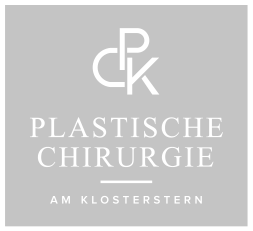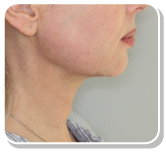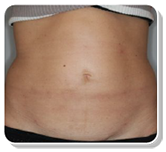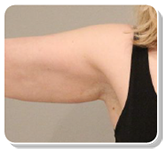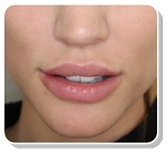Chemical Peel
Offered at our convenient location in Hamburg

A chemical peel is a resurfacing treatment in which a customized solution is applied to the facial skin. Peels remove the top layer of dead skin to reveal the fresh new complexion beneath. The skin that grows back after a chemical peel is smoother and more revitalized. Some chemical peels are capable of minimizing scars, wrinkles, and certain types of skin discoloration. Peels are often utilized on their own, but medical professionals can use them in combination with other cosmetic procedures to complement their final results.
Under the expert leadership of Dr. Dalia Tobbia, Plastische Chirurgie am Klosterstern is the premier aesthetic destination in Hamburg. To learn how a chemical peel can help you to rejuvenate your skin, contact Dr. Dalia Tobbia online or call +49 (0) 40 46 091 076 to speak with a caring cosmetic specialist.
Contents
About Resurfacing Treatments
Aging is a natural process, but it can be accelerated by lifestyle and environmental choices. Sun exposure contributes to photoaging, a process that wrinkles and discolors the skin. Age spots may appear prematurely due to overexposure to ultraviolet (UV) rays. The skin can become leathery and dry due to excessive time in the sun without the proper SPF lotion to protect it from damage.
Over the course of several treatment sessions, chemical peels can reduce signs of photoaging caused by sun exposure. Sometimes, only one deep peel is required to erase textural inconsistencies, and blemishes. Finding the correct formula for your skin type and the concerns you would like to treat is essential.
Light Chemical Peel
This removes only the superficial layer of skin cells and can be used to treat mild acne, oily skin, and enlarged pores. Overall, these treatments are great for those who want to achieve a natural glow that won’t require downtime due to peeling or possible irritation. Patients can receive these gentle peels as often as once a month or two to three consecutive sessions depending on their desired outcome. These are often formulated with glycolic acid or low concentrations of salicylic acid, and they are suitable for all Fitzpatrick skin types (from fair to dark). (1) AHA (alpha hydroxy acid), BHA (beta hydroxy acid), and certain retinoid peels are all considered light peels.
Medium Chemical Peel
Medium peels are powered by trichloroacetic acid (TCA). A 35% TCA compound can remove the superficial layer of skin cells as well as the outermost layer of the “dermis” (the intermediate layer of skin cells). Medium peels are effective at reducing the appearance of dull skin and fine wrinkles, but they can also promote a more even skin tone. Patients only need to undergo one medium chemical peel per year to maintain results. (2,3)
Deep Chemical Peel
The most robust level of peel removes underlying dermal layers to treat deep wrinkles and scars. A deeper peel usually produces more pronounced results, but the recovery times are also longer. Practitioners work with patients to properly prepare them for a deep chemical peel. The solution often contains phenol (carbolic acid). This type of peel must only be performed very infrequently to allow skin to heal and regenerate. (4)
Benefits of Skin Rejuvenation
Your skin is one of the first aspects of your appearance that people notice. If it glows, as it should, you project a warm, youthful, and bright attitude. But if insecurities and impurities obstruct the look of your face, you may shy away from social situations and continually feel self-conscious. By peeling away rough patches and uneven skin tone, Dr. Dalia Tobbia can restore your complexion along with your confidence. All in all, peels:
- Are non-surgical, yet effective
- Promote healthy skin regeneration
- Reduce the appearance of fine lines
- Even textural imperfections
- Lighten liver spots and hyperpigmentation
To experience the benefits of chemical peel from Dr. Dalia Tobbia, contact her office in Hamburg.
Eligible Candidates
Patients who are in good health and wish to restore their skin’s youthful luster may be ideal candidates for a chemical peel. If you have open sores or wounds, you must postpone your chemical peel treatment until your skin has properly healed. In general, those with sensitive skin should avoid deep peels that may produce more intense side effects for these individuals.
Advice and Treatment
Before you consider chemical peeling, we will conduct a physical examination of the treatment area(s). Dr. Dalia Tobbia will carefully assess the tone of your skin. Using this vital information, she will help create a skincare strategy tailored to your needs and goals. At Plastische Chirurgie am Klosterstern, we are firm believers in the power of communication. Please tell us how you would like us to revitalize your complexion, and we will formulate the right approach to your skin. Feel free to bring any questions that you may have to the consultation with Dr. Tobbia. As she works to address your concerns, she will help you make an informed, educated decision.
To determine your eligibility for a chemical peel, please call +49 (0) 40 46 091 076 and ask one of our staff members if chemical peels are right for you. Alternatively, you can reach out through our online form.
How to Prepare for a Chemical Peel
During your consultation, we will provide you with detailed instructions to prepare you for your chemical peel. These directions are tailored to your anatomy, goals, and your planned peel depth. Most patients prepare by avoiding exfoliating products and/or products with retinol/retinoids and refraining from sun exposure. Whatever your instructions may be, it’s vital that you follow these guidelines carefully to get optimal results.
The Chemical Peel Procedure
From the moment you arrive on the day of your procedure, Dr. Tobbia will provide a comfortable and clean environment. A clinician will cleanse your face to prepare it for the application process. Next, the chemical peel solution is directly applied to the skin with a brush. For a light chemical peel, there is no need for local anesthesia. For deeper peels, however, local anesthesia or pain medication are administered beforehand.
After a chemical peel of any depth, cooling agents are applied to the skin to minimize discomfort during the process. Finally, your provider will prescribe a regimen of cleansing, moisturizing, and protective ointments to facilitate your transition from peel to perfection.
Recovery and Results

As the name suggests, a light chemical peel removes the superficial dead skin layer within 4-7 days after the procedure. For deeper peels, the second layer of skin, the dermis, is also affected, so it could require up to 2 weeks of downtime as the skin repairs itself. As designed, the solution takes unwanted blemishes, scars, and discoloration with it. Once the solution is safely removed, the healthy skin beneath radiates and has a smoother, more rejuvenated look to it. Many patients experience redness and irritation similar to a mild sunburn during their recovery process. Deeper peels will cause more significant peeling and swelling, but Dr. Tobbia will prescribe the correct medications to ensure that you heal as comfortably as possible.
To get a preview of your marvelous mirror reflection to come, please see our glowing reviews. Patient satisfaction is Dr. Tobbia’s top priority, and she is excited to add you to her growing list of happy, healthy clientele.
Complementary Procedures
A chemical peel penetrates through the surface of the skin to reduce imperfections at various skin depths. To address your concerns from the inside out, consider the benefits provided by our suite of injectables:
BTX Cosmetic
Every time you express emotion, your facial muscles contract. Each contraction tugs at the skin, creating creases that deepen over time. BTX Cosmetic is a neuromodulator, a treatment that disrupts the repetitive movement of facial muscles by relaxing them, leaving behind a smoother, wrinkle-free skin surface. Results last anywhere from 3 to 4 months and do not negatively impact facial muscle function.
Juvéderm
Another root cause of wrinkles is the depletion of the skin’s support system, connective proteins like collagen and elastin. As we age, our bodies produce less of these proteins, the building blocks of vibrant skin. Gaps emerge beneath the surface of mature skin, leading to deflated, hollowed areas in the face. Dermal fillers like Juvéderm plump the gaps beneath the skin and smooth fine lines with hyaluronic acid (HA), a lubricating, hydrating substance naturally produced in the body. Hyaluronic acid also works to stimulate your skin’s production of collagen and elastin, promoting a stronger, more elastic skin quality that exudes youthfulness.
To find out more about other procedures for cosmetic enhancement, please visit Dr. Tobbia’s blog.
How Much Does a Chemical Peel Cost in Hamburg?
The depth of your peel will affect the price of your procedure. Dr. Dalia Tobbia will explain the cost of each component, but the ingredients of a chemical peel are formulated specifically for each client. Please call +49 (0) 40 46 091 076 to discuss your questions and concerns regarding aesthetic procedures and their associated pricing. You can also find out more by inquiring through our contact form available online.
FAQ
How often should I get a chemical peel?
Chemical peels are used to remove or exfoliate the top layer of dead skin, allowing new, more youthful, healthy skin to show through. The procedure varies based on whether you are treating sun damage, fine lines, sun spots, textures, or pores. Mild chemical peels can be done a few times a year to exfoliate the skin and improve skin texture. Medium peels are typically only performed every 3-6 months for best results. Deep peels are offered even more infrequently, as they require more downtime.
Are over-the-counter chemical peels safe?
While some over-the-counter chemical peels provide great results, there is a higher risk of developing a chemical burn if it is not performed by a medical professional. Over-the-counter peels also have lower concentrations of certain ingredients, so you will likely not get the same results as an in-clinic treatment.
Are chemical peels painful?
Light and medium peels may cause stinging sensations, but with anesthesia for a deep peel, you will not feel any discomfort during the procedure. Afterward, you may feel side effects similar to a sunburn, and some experience swelling.
References
- Zakopoulou, N., & Kontochristopoulos, G. (2006). Superficial chemical peels. Journal of Cosmetic Dermatology, 5(3), 246-253. https://doi.org/10.1111/j.1473-2165.2006.00254.x
- Monheit, G. D. (1989). The Jessner’s+ TCA peel: a medium‐depth chemical peel. The Journal of Dermatologic Surgery and Oncology, 15(9), 945-950. https://doi.org/10.1111/j.1524-4725.1989.tb03181.x
- Monheit, G. D. (1995). The Jessner’s-trichloroacetic acid peel: An enhanced medium-depth chemical peel. Dermatologic Clinics, 13(2), 277-283. DOI: https://doi.org/10.1016/S0733-8635(18)30081-0
- Landau, M. (2005). Advances in deep chemical peels. Dermatology Nursing, 17(6), 438. Retrieved from https://search.proquest.com/openview/5f0b1fb9ed30bd06bed7cbe55df1f4b7/1
